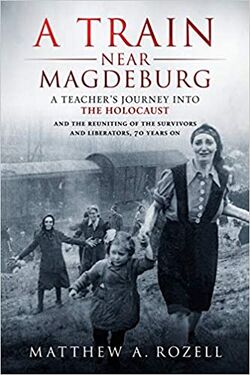Category:Magdeburg Train (subject)
Magdeburg Train (see Holocaust Children Studies)
- Terezin Train -- Troebitz Train -- see also Kastner Train
Overview
American troops of the 743rd Tank Battalion and the 30th Infantry Division came upon a railroad in Farsleben outside of Magdeburg. The train consisted of both cattle and passenger cars and contained approximately 2,500 concentration camp inmates, primarily Jewish. Many of the prisoners died during the transit, and most of the survivors were suffering from severe malnutrition and lack of medical attention.This train was one of three that left Bergen-Belsen between April 6 and 10 bound for Theresienstadt. The prisoners all held papers from neutral and non-European countries. Only one train arrived in Theresienstadt; the third was liberated by Soviet forces outside of Troebitz.
- Leslie Meisels (Hungary, 1927)
- Dola Horowitz (F / Poland, 1929)
- Sara Gottdiener-Atzmon (F / Hungary, 1933), Holocaust survivor -- Sara Gottdiener-Atzmon was born in Hahdunanas, Hungary in 1933, the fourteenth of sixteen children. At the age of seven, her father and four of her brothers were taken to a forced labor camp. The family was deported to Auschwitz in June of 1944 with the old people’s and children’s transport. In the same year Sara witnessed her father’s death as a result of hunger and deprivation.
At the end of 1944, the family spent four days undergoing disinfection at Strasshof. They were stripped naked and “were taken care of”. Half clothed, they were shipped to Bergen-Belsen. There they were made to stand outdoors in the snow for many hours during role call. As a small girl, she had a red child’s shoe on one foot and a woman’s high-heeled shoe on the other.
In April 1945, the family was liberated by the American army near the town of Magdeburg. At the age of twelve, weighing seventeen kilograms, Sara was given back her life. Her father Israel, three of her brothers, four nephews, her grandmother, brother-in-law, uncles, cousins, and many other family members (60 people altogether) had not returned from the camps.
The American army gave the survivors two alternatives, either to go to Palestine or to the United States. Without any hesitation, Sara and her family traveled via Buchenwald to Palestine. Once in Palestine, they had to go through a British transit camp in Atlit. Sara was in the first immigration group to arrive in Palestine in 1945 after the “deluge”.
Bibliography
- Matthew A. Rozell, A Train Near Magdeburg: A Teacher's Journey into the Holocaust
–From the author of 'The Things Our Fathers Saw' World War II narrative history trilogy–From the book:– 'I survived because of many miracles. But for me to actually meet, shake hands, hug, and cry together with my liberators—the ‘angels of life’ who literally gave me back my life—was just beyond imagination.'–Leslie Meisels, Holocaust Survivor– 'Battle-hardened veterans learn to contain their emotions, but it was difficult then, and I cry now to think about it. What stamina and regenerative spirit those brave people showed!'–George C. Gross, Liberator– 'Never in our training were we taught to be humanitarians. We were taught to be soldiers.'–Frank Towers, Liberator– 'I cannot believe, today, that the world almost ignored those people and what was happening. How could we have all stood by and have let that happen? They do not owe us anything. We owe them, for what we allowed to happen to them.'–Carrol Walsh, Liberator– '[People say it] cannot happen here in this country; yes, it can happen here. I was 21 years old. I was there to see it happen.'–Luca Furnari, US Army– '[After I got home] I cried a lot. My parents couldn’t understand why I couldn’t sleep at times.'–Walter ‘Babe’ Gantz, US Army medic– 'I grew up and spent all my years being angry. This means I don’t have to be angry anymore.'–Paul Arato, Holocaust Survivor– 'For the first time after going through sheer hell, I felt that there was such a thing as simple love coming from good people—young men who had left their families far behind, who wrapped us in warmth and love and cared for our well-being.'–Sara Atzmon, Holocaust Survivor– 'It’s not for my sake, it’s for the sake of humanity, that they will remember.'–Steve Barry, Holocaust SurvivorTHE HOLOCAUST was a watershed event in history. In this book, Matthew Rozell reconstructs a lost chapter—the liberation of a ‘death train’ deep in the heart of Nazi Germany in the closing days of the World War II. Drawing on never-before published eye-witness accounts, survivor testimony and memoirs, and wartime reports and letters, Rozell brings to life the incredible true stories behind the iconic 1945 liberation photographs taken by the soldiers who were there. He weaves together a chronology of the Holocaust as it unfolds across Europe, and goes back to literally retrace the steps of the survivors and the American soldiers who freed them. Rozell’s work results in joyful reunions on three continents, seven decades later. He offers his unique perspective on the lessons of the Holocaust for future generations, and the impact that one person, a teacher, can make.–Featuring testimony from 15 American liberators and over 30 Holocaust survivors-10 custom maps -72 photographs and illustrations, many never before published.-extensive notes and bibliographical referencesIncluded:BOOK ONE–THE HOLOCAUSTBOOK TWO–THE AMERICANSBOOK THREE–LIBERATIONBOOK FOUR–REUNION
Pages in category "Magdeburg Train (subject)"
The following 5 pages are in this category, out of 5 total.
